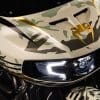The thought of a snake hitching a ride on your motorcycle sends shivers down the spine, but it has happened.
In the latest incident, a Mumbai man was alerted by another motorist to a snake under the seat of his Royal Enfield.
The rider stopped in the middle of Indian traffic and used a stick to coax the snake out.
A video of the incident was posted on Twitter.
Watch: A red sand boa, a non-venomous snake, slithering under the rear seat of a moving Royal Enfield motorbike at Virar (east). The rider was alerted by another biker who saw the moving snake. pic.twitter.com/hMWf4vcoyp
— TOI Mumbai (@TOIMumbai) July 7, 2020
Despite the Twitter caption, it’s a common cat snake (scientific name Boiga trigonata) which is semi-venomous and a good climber.
Snakes are fairly common in India in monsoon season.
Back in February an Indian man rode 11km with a snake in his helmet before he discovered it!

A least it didn’t attack like this snake!
Snake tales
Snakes have not only been known to hitch rides on planes, but also on motorcycles before as these videos show.
In Brisbane, a rider reports he once had a tree snake crawl across his handlebars and up his arm.
He didn’t know which end he was grabbing, but he picked it up and threw it off as he rode 100km/h along the M1 without falling off.
He did get a fright, but says he wasn’t too worried as he suspected it was only a tree snake as they climb (like the cat snake) while deadly brown snakes don’t.
Snakes are attracted to the warmth of the engine as well as the dark and warmth of the cavity under the seat.
The reptile usually boards the bike while it is parked somewhere.
We have run over many snakes while riding and none has been flicked up on to the bike.
They also like to climb up into cars as this Gladstone driver found this week.
Spiders are also common unwelcome hitchhikers.
I once rode almost 500km from Bateman’s Bay to Mudgee with a big spider on my jacket which I had stupidly placed on the ground while I drank my coffee.
Never, ever put your helmet or jacket on the ground! Lesson learnt.
On another occasion I had a hornet in my jacket that repeatedly bit me for several kilometres until I could find it and kill it.
If you are bitten by a snake, spider or other venomous creature, obviously seek medical attention as soon as possible.
The Royal Flying Doctor Service has a Fast First Aid booklet with advice for people with no medical training on how to manage first-aid situations. It includes managing a heart attack, snake bites, choking, burns and severe bleeding.
It is free in NSW and ACT only. To receive your copy text ‘NOW’ to 0428 044 444.
According to the University of Sydney, Australia is home to 60 species of snakes, including the 10 most lethal in the world.
There are about 3000 reported snakebites each year resulting in between 200 and 500 requiring anti-venom and an average of one or two fatalities.



RFDS guide on snake bites
- Do try to note the colour, size, distinctive markings and patterns of the snake without putting yourself at risk. A positive identification will help medics get the correct anti-‐venom into the patient more quickly.
- Do NOT wash the area of the bite or try to suck out the venom. It is extremely important to retain traces of venom for use with venom identification kits.
- Do NOT incise or cut the bite, or apply a high tourniquet. Cutting or incising the bite won’t help. High tourniquets are ineffective and can be fatal if released.
- Do stop the spread of venom – bandage firmly, splint and immobilise. All the major medical associations recommend slowing the spread of venom by placing a folded pad over the bite area and then applying a firm bandage. It should not stop blood flow to the limb or congest the veins. Only remove the bandage in a medical facility, as the release of pressure will cause a rapid flow of venom through the bloodstream.
- Do NOT allow the victim to walk or move their limbs.
- Use a splint or sling to minimise all limb movement. Put the patient on a stretcher or bring transportation to the patient.
- Do seek medical help immediately as the venom can cause severe damage to health or even death within a few hours.
Have you ever had a snake, spider or other unwelcome guest on your motorcycle? How did you deal with it? Leave your comments below.



